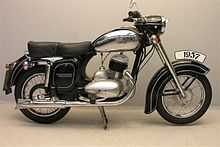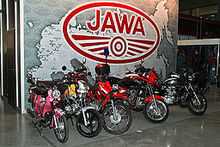Jawa Moto
 | |
| Founded | 1929 |
|---|---|
| Founder | František Janeček (1878-1941) |
| Headquarters | Týnec nad Sázavou, Czech Republic |
| Products | Motorcycles |
| Website | JAWA Moto |
JAWA is a motorcycle manufacturer founded in Prague, Czechoslovakia in 1929 by František Janeček,[1] who bought the motorcycle division of Wanderer. The name JAWA was established by concatenating the first letters of Janeček and Wanderer.[2] In the past, especially in the 1950s, JAWA was one of the top motorcycle manufacturers and exported its 350 (Pérák) into over 120 countries. Another famous model in the 1970s was the 350 Californian. It appeared in the typical black and red coloring from Californian beaches to New Zealand.[3] After 1990, there was a significant loss of production. A successor company was formed in 1997 in Týnec nad Sázavou, continuing the name as JAWA Moto.[1]
History
Origins - 1929





František Janeček started the company after working several years in the armament industry. Although he didn't have any experience with motorcycles, he was familiar with production techniques. Janeček chose between the Austrian double piston two-stroke motor of Puch, the Berlin two-stroke of Schliha, and the new Wanderer 500 cc. Janeček chose the Wanderer. Because of the collapse of the German motor industry, Wanderer had already decided to stop the production. This is because they didn't think it would be profitable to directly compete with BMW. The first model was introduced on October 23, 1929. This was a 500 cc 4-cycle engine with 12 kW of power (18 hp) and fuel consumption of 6 liters per 100 km. Although priced highly, through the first years (and several constructional fixes) this motorcycle was successful and was considered reliable.
1930s
Due to the economic recession of the early 1930, a cheaper and simpler motorcycle was needed. Year 1932 marked the introduction of JAWA 175, with its 3.6 kW engine. This light (70 kg) machine was capable of speeds up to 80 km/h and fuel consumption of 3.5 liters per 100 km. The first year of production was an immediate success, selling over 3000 of the JAWA 175, almost three times the number of the 500 cc model over three years of production. The production of this model was finally stopped 1946. In 1938 JAWA was the first to offer test rides during exhibition show. This test motorcycle was a custom JAWA 175 equipped with dual handlebars, second pair being in the back for the instructor. Over the years total of 27,535 units of the JAWA 175 were built.
1940s
The company founder František Janeček died. Post-war production of JAWA 250/350 motorcycles restarted, and production of the JAWA 350 Ogar motorcycle began.
1950s
Motorcycles produced in the 1950s include the 250/350 (Model 353/354), 500 OHC and the 50 Pionyr and Jawetta mopeds. A powerful 2-stroke motorcycle known as the JAWA 250/350 with the compact engine, rear wheel suspension and many other innovations was exported to more than 120 countries worldwide. It was one of the most successful models of JAWA.
1960s
- 1962, Amalgamation with ESO in production of JAWA speedway motorcycles
- 1963, Closure of JAWA plant in Prague – Pankrác
- 1964, Start of production in new plant at Týnec nad Sázavou
- 1964, Production of millionth JAWA brand motorcycle
- 1965, Start of production of JAWA 350 Automatic motorcycles
- 1966, Start of production of JAWA 350 Californian (type 363) motorcycles
- 1967, Start of production of JAWA 90 (cross, trail, roadster)
- 1967, Start of production of JAWA 50 Mustang (type 23)
1970s
- 1970, Start of production of JAWA 250/350 ÚŘ motorcycles
- 1970, Start of production of JAWA 350 Bizon motorcycles
- 1974, Start of production of JAWA 350 (type 634) motorcycles
- 1976, Production of two millionth JAWA brand motorcycle
1980s
- 1984, Start of production of JAWA 350 (type 638) motorcycles
- 1987, Production of three millionth JAWA brand motorcycle
1990s
- 1991, Start of production of JAWA 350 (type 640) motorcycles
- 1994, Start of production of JAWA 250 (type 593) motorcycles
- 1994, Start of production of JAWA 50 (type 585, 586) motorcycles
- 1997, Founding of the company JAWA Moto spol. s r. o.
- 1998, Start of production of JAWA 125 Travel motorcycles
- 1998, Joing with MOTOUNION, take-over of bike MUC 125 Dandy production
- 1998, Start of production of JAWA 125 Dandy motorcycles
- 1999, Start of production of JAWA 100 (type 587) motorcycles
2000s
- 2004, Start of production of JAWA 650 (type 836) and JAWA 650 Classic motorcycles
- 2005, Start of production of JAWA 650 Style motorcycles
- 2006, Start of production of JAWA 650 Dakar motorcycles
- 2008, Start of production of JAWA 250 Travel motorcycles
2010s
- 2011, Start of production of JAWA 660 Sportard motorcycles (successor to 650 Dakar)
- Start of production of JAWA 350/634 Retro motorcycles
- Developing of JAWA 1000/1200 motorcycles
Other activities
JAWA automobiles
In 1934 JAWA introduced its first car, the JAWA 700, which was DKW-based. In 1937, the modified JAWA 600 Minor was introduced. Production continued in limited numbers throughout WWII, and some were assembled in the immediate postwar period.[4]
JAWA mopeds
JAWA made a variety of mopeds with two-stroke engines, including the Babetta, and was one of the first companies to include electronic ignition on their mopeds.
JAWA in India
JAWA motorcycles were introduced in India in 1960 and they have a cult following to this present day. Production was carried out directly in India by Ideal Jawa India Ltd based out of Mysore. The JAWA 353/04 designated as 'A' Type, Yezdi 250 'B' Type, Jawa 350 type 634 Twin and Yezdi 250 Monarch models are driven to this day in various parts of the country. JAWA and Yezdi bikes, especially the ones with fuel tank paddings and ignition systems on the fuel tank are now collectors items. The company stopped production in 1996.
Racing
Historically JAWA had been very active in racing, and by far the most active East-European manufacturers in mechanical sports. In track racing JAWA sustained a presence in the World Championship until the mid-sixties with respectable performances considering their limited budget. In Motocross the firm built an impressive palmares before its four-stroke engines became superseded by two-stroke engines. In speedway racing, dirt track racing and ice racing where four-stroke engines were still at an advantage, the firm remained a dominant force. The separate factory where these competition motorcycles were built became a separate company following the privatizations of the 1990s with the fall of Socialism.
Speedway World Champions who have ridden successfully on Jawa bikes include Ivan Mauger, Barry Briggs and Ole Olsen.
Recent information

Following the dissolution of Czechoslovakia and the dismantling of the communist bloc, the Jawa consumer motorcycles and the Speedway competition bikes were divided into separate companies. In the nineties, JAWA Speedway bikes were successful, while the Jawa company has struggled. As of 2006 the JAWA mostly produce bikes similar to Honda 250 cc, 125 cc and 50 cc motorcycles and large bike with a 650 cc Rotax engine (this engine can be also found in BMW F650 series). The iconic 350 cc two-stroke twin, is almost mechanically unchanged since the 1960s but very reliable, currently are successfully sold mainly to the countries of Central America and Russia.
The large bike with 650 cc Rotax engine comes in three different variations. JAWA 650 classic is a retro bike with classic proportions. JAWA 650 Style is aimed for city streets and finally JAWA 650 Dakar is a full-scale enduro bike similar to Honda XL Transalp.
Currently models (2014) sold by the JAWA company are: JAWA 50, JAWA 125, JAWA 250, JAWA 350 and JAWA 660 Sportard.
References
- ↑ 1.0 1.1 Jawa company Retrieved 2014-03-01
- ↑ "History of Jawa". Westcoast Motorcycles. Retrieved 2014-03-01.
- ↑ Jawa Californian je zpátky. Retro z garáže se povedlo
- ↑ "New Czech Car Is Built", August 1946, Popular Science drawing of unique features of Minor automobile
External links
| Wikimedia Commons has media related to Jawa motorcycles. |
- Official website www.jawa.eu